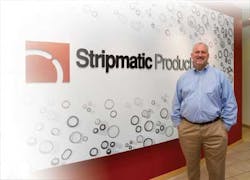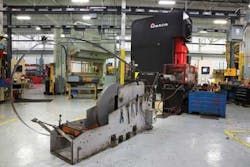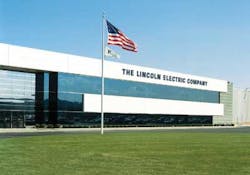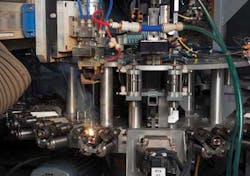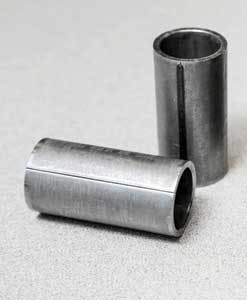Banding together improvises new product
Paul Denney
Many companies become complacent in the "old way" of doing things and have little interest in introducing new approaches and ideas. Stripmatic Products Inc (www.stripmatic.com), a 67-year-old company specializing in the stamping of tubular parts, does not fall into that category. The company, owned by Bill and Liz Adler since 1992, is a supplier of high quality, split-seam bushings, spacers, and tubular parts to various industries. Stripmatic's major markets are the automotive and heavy truck industries, where it makes supplies such as parts for chassis, frames, suspension bushings, and seat frames. The parts also are used in axles' "spider" assembly and suspension systems for heavy trucks. Stripmatic also supplies its wrapped bushings to builders of conveyor chain systems, appliances, lawn and garden implements, and agricultural equipment.
Bill Adler (FIGURE 1), who is the 2013 president of the Precision Metalforming Association (PMA), was easily able to evaluate how his company compared to others within the PMA. Since purchasing the company, the Adlers have invested in continuous product improvements to increase sales per employee by 230%, while evaluating potential new markets.
Servo presses investigated
As part of a relocation effort, Stripmatic moved to a newly renovated 60,000-square-foot facility in Cleveland. During that time, the Adlers looked at new technologies that would open more sales opportunities and markets. One upgrade was to transition from traditional mechanical presses to servo presses, which would permit higher production and other controls not possible with their older equipment.
"To expand our product capabilities, we needed one press with more tonnage and a 6 in. stroke (FIGURE 2) to be able to make heavier wall tubes, and another press with a 12 in. stroke to make 3 in. or larger diameter tubes," states Bill Adler. "With the flexibility that a servo press offers, we can do both of those operations in one press and actually achieve faster production rates on both systems."
Another area of interest for Adler was to compete in the non-split tubular market. Stripmatic was unable to bid on the non-split tube jobs because customers could not have a split seam in the part. The non-split tube jobs went to companies that would take tube product and cut it to length. While splitting of tubes would appear to be a low-cost approach, producing tubes with the correct diameter and wall thickness could be costly. However, Stripmatic had an advantage. The company worked with lower cost strip material that could be formed to the desired diameter. Additionally, Stripmatic could also stamp other features required by the customer, eliminating a secondary process. The most important issue for Stripmatic was how to eliminate the "seam" in its products.
Bill Adler explains, "We compete primarily against cut-off tube operations. If we want to offer our customers a lower-cost part, we have to guarantee 100% good seam welds produced at a very high rate of speed. Because welding was not our core competency, we needed outside expertise to help us determine if this could be done competitively. We turned to Lincoln Electric, which is recognized as a global leader in welding systems and conveniently located right in our own back yard - Cleveland!"
Turning to Lincoln Electric
Lincoln Electric, a world leader in arc welding equipment and consumables (FIGURE 3), is known for helping customers find the right solution for their joining needs. Working with Lincoln Electric Automation, Stripmatic examined a number of approaches, including gas tungsten arc welding and plasma welding. While the initial results of plasma welding and a semi-automatic line were promising, it was quickly determined that the plasma process was too slow and transferred too much heat into the parts. Lincoln Electric then proposed to Stripmatic that it look at laser welding.
Lincoln Electric, traditionally an arc welding company, has monitored progress with lasers over the years. With the development of higher power fiber, disk, and direct diode lasers, the company realized that these lasers could be used in many of the market sectors it serves. Lincoln Electric had already worked with some of its customers to accomplish laser hybrid processing, develop special consumables, and modify its digital power supplies. In 2010, Lincoln Electric Automation partnered with IPG Photonics (www.ipgphotonics.com), located in Oxford, MA, to work with potential customers, develop new processes, and market laser systems. Since establishing its laser facility, Lincoln Electric has been working on internal and external welding and cladding efforts. Throughout the past few years, Lincoln Electric has expanded its capabilities through a number of acquisitions involved with and/or supporting laser processing efforts including Techalloy™, manufacturer of stainless and nickel alloy wire; Weartech™, a producer of cobalt-based and nickel alloys; Wayne Trail™ (www.waynetrail.com), a designer of automated metal forming, fabricating, and joining systems; and Tennessee Rand™ (www.tennrand.com), a tooling and systems integrator.
"We have been watching this technology for a number of years. High power lasers have become more reliable, more efficient, and less expensive to purchase and operate. The laser process has always provided good performance for both joining and cutting; it just was too expensive to own and operate for most fabricators," states Chris Bailey, GM, Lincoln Electric Automation.
Bailey explains, "The applications that can utilize higher power lasers, and specifically the hybrid welding and hotwire brazing processes, reach across all industries and materials. Our Power Wave® software solution technology brings a new level of performance and quality compared to conventional laser and arc welded processes. With the addition of Wayne Trail and Tennessee Rand, Lincoln Electric will be able to offer a broad range of systems solutions to our integration partners and our customers."
Working with Lincoln Electric, Stripmatic was able to prove to its customer base that the laser tube parts met customer requirements for equivalent non-split tube parts. Stripmatic conducted trials on representative production products. The trials demonstrated that welding could be accomplished on a wide range of material thicknesses and penetrations, plus it also determined the potential production rate for various laser powers. As the development process continued, Stripmatic brought a number of its customers to the Lincoln Electric Automation facility to demonstrate the potential of a "fabricated" bushing and prototype parts with unique designs that were not possible from present methods. Based on the performance results of the prototype components and support from its customers, Stripmatic moved forward with defining a work cell for its targeted market.
Fastfeed joins efforts
While Stripmatic's welding efforts were accomplished by using a Lincoln Electric robotic system, it was clear that desired production rates from specialized material handling would be required in the production system. Stripmatic turned to Fastfeed (www.nailfeeder.com) in Lodi, OH, another local company, to develop the laser welding cell. The concept was to develop a system that would automatically feed the parts from a "bowl," find and position the seam of the parts, and present them to the laser head for welding. The system would also inspect the part post-weld to ensure weld quality. While such material handling and sensing of high volume parts was not new to Fastfeed, including a laser welding component as part of the system was (FIGURE 4).
The final work cell was a joint effort. Based on prototype runs of actual parts, Lincoln Electric was able to determine that a 2 kW IPG Photonics fiber laser would meet the processing requirements for the "near term" parts that Stripmatic expected to weld. The laser was ordered with a beam switch that allowed for a second "cell" along with additional capability to upgrade the laser to a higher power, if needed. The final integration occurred in November 2012 on Stripmatic's production floor with qualification parts coming off the system within a week of the installation. While Stripmatic had accomplished some plasma welding of parts, the new laser system represented a major expansion of its capabilities and product offering.
With production increasing after the initial installation, Stripmatic ordered another cell from Fastfeed to be used in developing new products. This system was the same as the production system but did not have the part-handling capability. Because the optics and motion were accomplished with identical components as the production system, Stripmatic personnel would be able to develop processing procedures/parameters and directly implement those specifications on the production system.
"By using Lincoln Electric, we were able to determine a new way to add value to our niche process and use new technology to gain a competitive advantage," says Bill Adler. "This laser welding capability will help us break into new markets and new applications that we previously could not compete in." See FIGURE 5.
"The expertise of the staff at Lincoln Electric is helping Stripmatic break into the world of laser welding," adds Adler. "I am extremely excited to see the number of new opportunities that this technology can open up for us. I feel even more comfortable, as a newcomer to production welding and laser, that we have Lincoln Electric's technical team right in our back yard!"
Paul Denney([email protected]) is senior applications engineer at Lincoln Electric, Cleveland, OH.
More Industrial Laser Solutions Current Issue Articles
More Industrial Laser Solutions Archives Issue Articles

